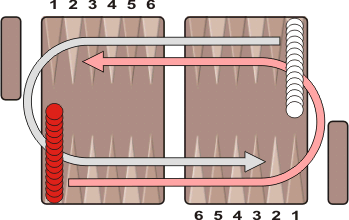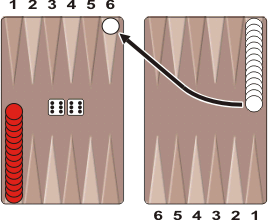![[Backgammon Galore!]](/gif/GaloreButton.gif)
|
|
Backgammon Variants Setup: Each player starts with fifteen checkers on the rightmost point of the far side of the board, at diagonally opposite corners from each other. They both move in the same direction, counterclockwise, around the board.
Object: The object of the game is to move all your checkers around the board and bear them off. White bears off at the lower-right; Red bears off at the upper-left. To start: Both players roll one die and the higher number goes first. That player rolls the dice again to begin his turn. Movement: The roll of the dice indicates how many points, or pips, the player is to move his checkers. The following rules apply:
First checker away: Your first checker must pass the opponent's starting point before you may move any of your other checkers.
No hitting: A major difference between Moultezim and other forms of backgammon is that there is no hitting in this game. One checker by itself controls a point, and an opposing checker may not land or touch down there. Opponent's starting table: You may not occupy more than four points in the opponent's starting table. This keeps players from forming a prime directly in front of their opponent's starting pile. Bearing Off: Once you have moved all fifteen of your checkers into their finishing table, you may begin bearing off. You bear off a checker by rolling a number that corresponds to the point on which it resides, then removing the checker from the board. If there is no checker on the point indicated by the roll, you must make a legal move using a checker on a higher-numbered point. If there are no checkers on higher-numbered points, you must remove a checker from the highest point that has a checker. Scoring: The first player to bear off all his checkers wins the game and scores one point. If the winner bears off all his checkers before the loser has borne off any, he gets two points.
References
|
![]()
Backgammon Galore : Variants


